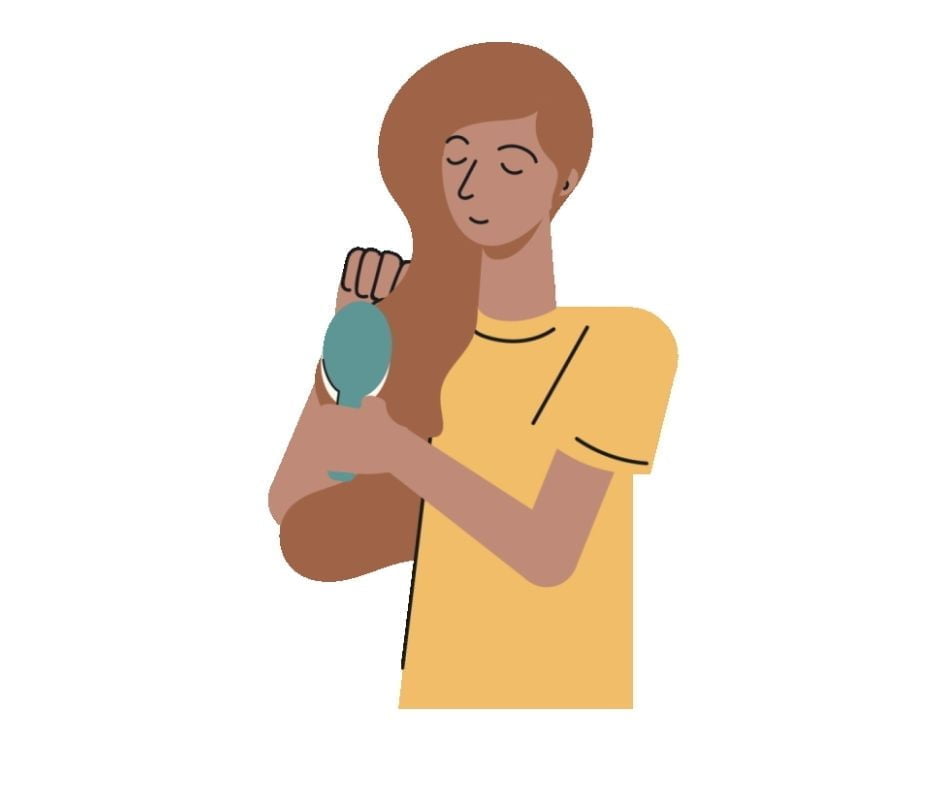How to stop hair from tangling at nape of neck

Have you tried every tangle-prevention technique you can think of? Or does it just seem like your hair gets tangled and blotchy whenever you touch it?
Cleaning hair after showering and conditioning can be a real pain if you have nape tangles and knots. I have always had trouble with this area, so I have been trying to find the best way to prevent it from getting tangled. After spending time on research, and experimenting with many products I have been able to find ways to fix and prevent hair tangles.
I will be sharing with you some tips here:
Can you comb out tangled hair at the nape of your neck?

Yes, you certainly can. It’s actually quite simple.
The trick is to start pulling out tangles in the direction of hair growth with a wide-toothed comb. Beginning from the bottom of the neck and making your way up, instead of the top and going down, is the way to go.
You should also work from one side of your head to another so that you don’t get tangled up in knots yourself!
Once you’ve worked out all the tangles, you can braid or twist your hair and pin it up on your head (if you have long enough hair for braids or twists). This will keep it out of your face while you sleep.
Why does my hair tangle at the nape of my neck?

The hair at the back of your neck is different from the rest of your hair. It contains properties that cause it to tangle more easily. Here’s how to avoid tangles in this area and what causes it.
Hair, like skin, is composed of several layers. The cuticle, the outermost layer, is densely packed with scales that overlap. These scales are formed in an overlapping pattern, with tiny microscopic grooves between them that aid in the distribution of natural oils throughout the hair shaft. The cuticle also shields your hair’s inner layers from external aggressors like heat and UV rays.
When you brush or comb your scalp-level hair, these cuticles lie flat against each other and there is no space between them for tangles to occur. However, when you brush or comb your crown-level hair (especially if it’s very long), those cuticles tend to rise up slightly because they’re not protected by other strands of hair above them anymore. This creates gaps between them which allow tangles to form when you brush or comb your crown-level hair too vigorously or irregularly.
How do I prevent long hair from tangling at the nape of my neck?

Tangles in the hair can be produced by a multitude of factors, including products, the weather, and even over-brushing. The great news is that entanglement can be avoided completely.
Follow these guidelines to avoid tangles at the nape of your neck:
Keeping your hair hydrated is the greatest method to avoid tangles. Using a leave-in conditioner and deep conditioning once a week is the easiest way to do this. Additionally, avoid using too many products on your hair at the same time. Your hair will be less likely to tangle if you use less products.
A good detangling product is also very important for preventing tangles. These products protect the hair from breakage and help to untangle knots without causing damage. They also create slip, which helps them glide through the hair easily without causing breakage or pulling out strands of hair.
It’s ideal to detangle your hair when it’s dry because damp hair has more tension than dry hair, making it more difficult to comb through smoothly. This allows you to pluck out strands of your own hair, making knot removal easier.
As you comb damp hair, you’ll end up with more tangles than you need when it dries and tightens up again. To avoid breaking your hair while attempting to detangle it, wait until it is completely dry before combing.
Apply a leave-in conditioner or style lotion to the ends of dry or curly hair before using a broad tooth comb to remove knots or tangles in those regions (or brush). Brushes and combs will be able to glide more easily across these places, preventing hair strand breakage if pulled too hard.
Why is my hair tangling underneath?
There are a number of reasons why your hair may be tangling underneath
Dry Scalp
Breakage and matting might occur if your scalp is dry. Dandruff and flakes get caught in your hair, making it look lifeless and frizzy. Consider using a thick moisturizing shampoo every time you wash your hair if you see this happening.
This will aid in the restoration of some of the natural oils that have been depleted by chemicals in other shampoos. To help maintain moisture packed into each strand of hair, use conditioner after washing.
Hair Product
Certain hair treatments contain harsh ingredients that, when rinsed out with water, can damage your hair’s cuticle, making it more prone to tangling and breakage. If you use these products on a regular basis, as well as other harsh treatments like perms or relaxers, you should switch to milder products that don’t include any chemicals that could harm the health of your hair in the long run. It’s also a good idea to avoid combining too many different styles at once.
Why does my hair tangles so much?
The hair around your neck is the most delicate and sensitive on your head. Long hair necessitates extra attention.
Chemical treatments
Tangling is more common after coloring or bleaching your hair. Tangling is more likely in hair that has been colored or bleached. Chemical treatments can cause hair to become stiff, dry, and fragile.
poor nutrition
Your food has a significant role in maintaining the health of your skin, nails, and hair. A lack of vitamin E, for example, can cause dryness in the scalp, making tangling more likely in those who are low in this essential.
The deficiency of zinc can also cause diseases like eczema. Meals containing all necessary nutrients will help you maintain your nails, hair and skin and make them grow healthy. Zinc deficiency can easily cause hair tangling.
You’re using the wrong products
When it comes to your hair, what you put in it is just as important as what you put on it. Certain products can make your hair super soft and healthy, while others can make it dry, brittle and prone to tangling.
If your locks are constantly getting tangled up, you might want to take a look at what you’re using on them. If you’re unsure about which products are right for your hair type, check out our guide to choosing the best hair products for every type of hair.
You use too much heat styling tools
Heat styling products like flat irons, blow dryers, and curling irons are fantastic for generating elegant styles and adding volume to your locks, but they can also injure your strands if used too often or at too high temperatures, making them one of the principal contributors of knots in our look.
Blow dryers and straightening iron, among other heat styling products, can damage your hair and make it more prone to breaks. Later in life, this makes it more likely to tangle.
Does Olive Oil detangle hair at nape of neck?
Olive oil is a fantastic natural hair moisturizer. Since it contains vitamins and minerals that promote healthy hair growth, it has been used as an organic conditioner for a long time.
Use your fingertips to gently work a little amount of olive oil through your hair from root to tip to detangle it. It will astound you with how quickly it detangles even the most twisted strands.
Because of its high vitamin and mineral content, olive oil has long been used in organic conditioners to promote hair growth.
However, you should avoid using too much of this to prevent your hair from becoming weighed down. Apply a small bit of olive oil to each region of hair for the finest results.
Does coconut Oil detangle hair at the nape of the neck?
Coconut oil is a great natural product that can be used for many things. It can be used as a hair conditioner, an eye makeup remover, body lotion, lip balm, and many more things.
Coconut oil has been known to help with hair growth, skin care, and even weight loss. It is rich in vitamin E and other minerals that help nourish your scalp and hair follicles.
Coconut oil has been known to prevent the breakage of strands and make your hair soft and shiny. It also helps eliminate dandruff from your scalp by balancing the pH level of your scalp.
You can use coconut oil as a detangling agent on wet or dry hair depending on what type of style you want to achieve. If you want to use it while your hair is wet then simply rub some coconut oil into your hands and run them through your hair from roots to ends until all the tangles are gone. If you want to use it after washing then simply apply some coconut oil onto dry hair and then brush or comb through with your fingers or wide-toothed comb until all the tangles are gone.
